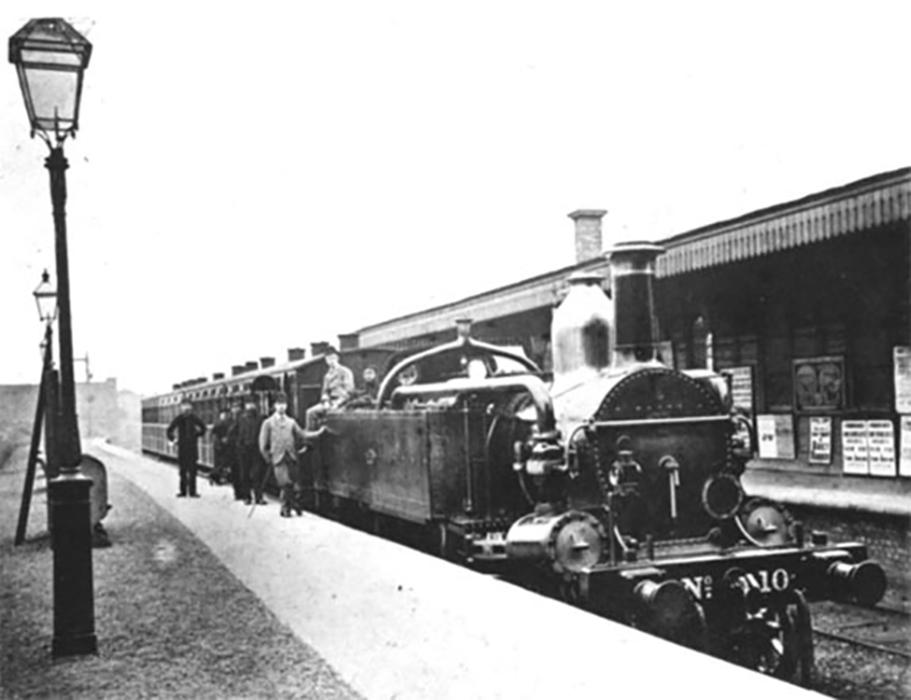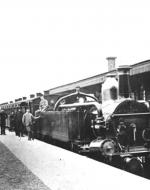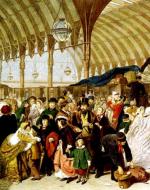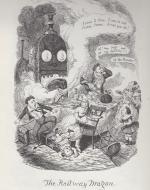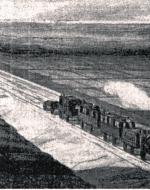Created by Catherine Golden on Wed, 10/13/2021 - 18:53
Description:
"Since the invention of printing, no discovery has been made that has exercised so great a change and produced such remarkable and beneficial results to the whole human race as has the introduction of railways and that of steam carriages. By steam-locomotive power distance has been comparatively annihilated, and in conjunction with steam navigation, it has practically reduced the dimensions of the earth." --The Illustrated London News, October 1864.
The railway boom of the 1840s had a major impact on Victorian life and fiction. The above article in The Illustrated London News published in1864 likens the invention of the railroad to the printing press. Gutenberg's 1436 printing press launched a global news network and majorly changed the world. However, the railroad invention that seemingly "reduced the dimensions of the earth" by making distance surmountable was not always viewed as beneficial. Victorian authors illustrate the railway's disruptive effect on the English landscape and daily life accompanying "railroad mania," "the Victorian equivalent to the dot.com bust of the 1990s," as George Landow notes in "Railways and Victorian Literature" (https://victorianweb.org/technology/railways/rrlit1.html). Authors across the long nineteenth century from Elizabeth Gaskell in the 1840s to Margaret Oliphant in the 1870s and Victorian American Kate Chopin in the 1890s use the railroad to advance the plot, at times animating the railway by turning its whistle into a "scream" and its engine into a snorting animal. As these stories reveal, the railroad was a sign of innovation that also brought disastrous consequences that determine the outcome of fiction by Oliphant and Chopin.
"The Engine," West Brompton Station, London, 1876 from John Betjeman's Victorian and Edwardian London from Old Photographs, 1969, Plate 151. Wikipedia. The railway was a symbol of innovation that transformed all aspects of Victorian life. Prior to the coming of the first major railway line from Manchester to Liverpool in 1830, most people rarely traveled a distance of more than 10 miles. While the new technology was initially feared--the fast moving train might make it difficult to breathe or effect the health of one's eyes--by 1850, Victorians flocked to this new form of transportation for business and leisure. From the steam engine pioneered in 1825 by George Stephenson came developments in all sorts of railway travel for Victorians across the social classes. There were three classes of train travel in Victorian England, which reflected the rigid class structure of the period. First class carriages were fully enclosed with upholstered seats while second class carriages had a roof but open sides and wooden benches. Third class carriages had no roof and hard wooden seats, and passengers were fully subjected to the elements. There were trains for long trips and others for district use akin to our commuter trains today. Betjeman describes this particular train as follows: "The Engine, a 4-4-0Ts, had been introduced twelve years earlier. It came to be used exclusively on the District Railway, and widely on the Metropolitan."
William Powell Frith, The Railway Station, 1862, The Victorian Web. Frith is heralded as one of the great Victorian narrative painters who captured the fabric of daily life in canvases designed to tell a story. His paintings take us to the seaside in Ramsgate Sands (1854), into London's bustling post office inThe General Post Office, One Minute to Six (1860), and onto the platform of a crowded railway in The Railway Station (1862). This monumental Victorian narrative painting, which took Frith a year to complete, captures the diverse crowd using London's Paddington Station in the 1860s. Frith captures a London version of what Elizabeth Gaskell in Mary Barton refers to as a "motley assembly" of Victorians who, along with Mary Barton, board the Manchester train bound for Liverpool in Chapter XXVI. In Frith's crowd of young and old, wealthy and impoverished, human and canine, we find a bride and bridegroom, perhaps embarking on a wedding tour as Janey and Mr. Rosendale do in Oliphant's "A Story of a Wedding Tour"; Scotland Yard detectives in the process of making an arrest; and a mother saying goodbye to her son, carrying a cricket bat and likely heading to school. We can easily imagine Mary Barton in her "blue gown and obnoxious plaid shawl" taking her place on a similar railway platform bound for Liverpool.
George Cruikshank, "The Railway Dragon," in George Cruikshank's Table Book Edited by Gilbert Abbott A Beckett, 1845, Dover. In Gaskell's Mary Barton, the train allows Mary, who has never left Manchester, to travel to Liverpool to save Jem Wilson, wrongly accused of murder, by finding Will Wilson, who can provide an alibi for Jem. Gaskell reveals the social class divide in the 1840s in noting, "Common as railroads are now in all places as a means of transit, and especially in Manchester, Mary had never been on one before" (XXVI). In Chapter XXVI, Mary feels "bewildered by the hurry, the noise of people, and bells, and horns; the whiz and the scream of the arriving trains." Gaskell not only turns the train whistle into a "scream," but she also articulates Mary's distress in being surrounded by the noises and "whiz" of the railroad. Three years earlier, caricaturist George Cruikshank in "The Railway Dragon" (1845) anticipates the feelings Mary Barton experiences in his depiction of an animated locomotive invading the home of John Bull, a symbol of Englishness and the personification of England. The train with glaring lights that look like eyes terrifies Bull and his wife and children, knocking the toddler to the ground. The locomotive's billowing smoke seems to "scream" at all English men and women who fear "the Monster."
"The Liverpool-Manchester Railway at Chat Moss," from Isaac Shaw's Views of the Most Interesting Scenery, 1831. Once Gaskell's Mary Barton gets acclimated to the train, she gains a new appreciation of the mode of transport and her surroundings. Gaskell writes in Chapter XXVI of Mary Barton: "The very journey itself seemed to her a matter of wonder . . . The cloud-shadows which give beauty to Chat-Moss, the picturesque old houses of Newton . . . she seemed to look at them earnestly as they glided past." As this picture and others in Shaw's book demonstrate, Gaskell provides a very accurate description of the landscape and houses outside the train window on the route from Manchester to Liverpool. The shadows from the clouds over Chat Moss in the scene here depicted and the "picturesque old houses of Newton" lead Gaskell scholar Alan Shelston to note that "Gaskell was certainly a frequent traveller on the line," but also to observe: "it may well be that her account is from these illustrations rather than from her own observation" (95). I recommend to the interested reader Shelston's article, "Opportunity and Anxiety: Elizabeth Gaskell and the Development of the Railway System" (Gaskell Society Journal 20 [2006]: 91-100.
Frederick Sandys, "Margaret Oliphant," sketch, 1881, National Portrait Gallery, London, Wikipedia. Margaret Oliphant (1828-97) was a prolific Scottish author widowed at a young age who supported her family and her brother's family by her literary earnings. Sandys shows her to be a conventional Victorian woman dressed conservatively in a high-necked gown with a lace collar and wearing a mobcap to cover her hair, an indoor fashion that aligns her more with the early than later Victorians. In her short story entitled "A Story of a Wedding Tour," Oliphant uses the train as a major plot device. While the train allows Gaskell's Mary Barton to get to Liverpool to defend her lover, the train in this Oliphant story determines the life of protagonist, Janey, who, by an accident of the railway seemingly escapes from her unhappy marriage to Mr. Rosendale to live on the continent posed as a widow. Oliphant uses the train as a vehicle for freedom which is short-lived, however, leaving Janey as a sorely disappointed heroine. Interestingly, Oliphant places responsibility on the train for Janey's escape and return to the neglectful Rosendale, noting: "This was how the train brought back to Janey the man whom the train had separated from her ten years before. The whole tragedy was of the railway, the noisy carriages, the snorting locomotives." The train in this short story functions as a character that provides freedom but ultimately shows a woman cannot escape her marriage.
Film Clip from a 1997 adaptation of Kate Chopin's "The Story of an Hour" (1894), written and directed by Bradley Pontecore. Asa Briggs notes in Victorian Things (2003), "Railways were symbols of improvement, but they also brought with them disasters, as did steam boilers, and even bicycles" (19). In her short story initially published in Vogue under the title "The Dream of an Hour," Kate Chopin cleverly uses a train disaster to structure her tale about a woman named Louise Mallard who seemingly comes alive with the news that her husband has allegedly died in a train accident, only to die herself when she discovers he is alive. The film clip shows Louise looking out the window where "She could see in the open square before her house the tops of trees that were all aquiver with the new spring life." Louise, too, feels this "new spring life" and cannot return to restrictive married life; she dies "of the joy that kills." As in Oliphant's story, the train becomes a vehicle for a woman's liberation from patriarchy but also the harbinger of not only disappointment but the heroine's own death.

